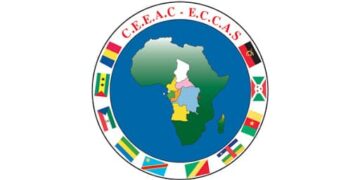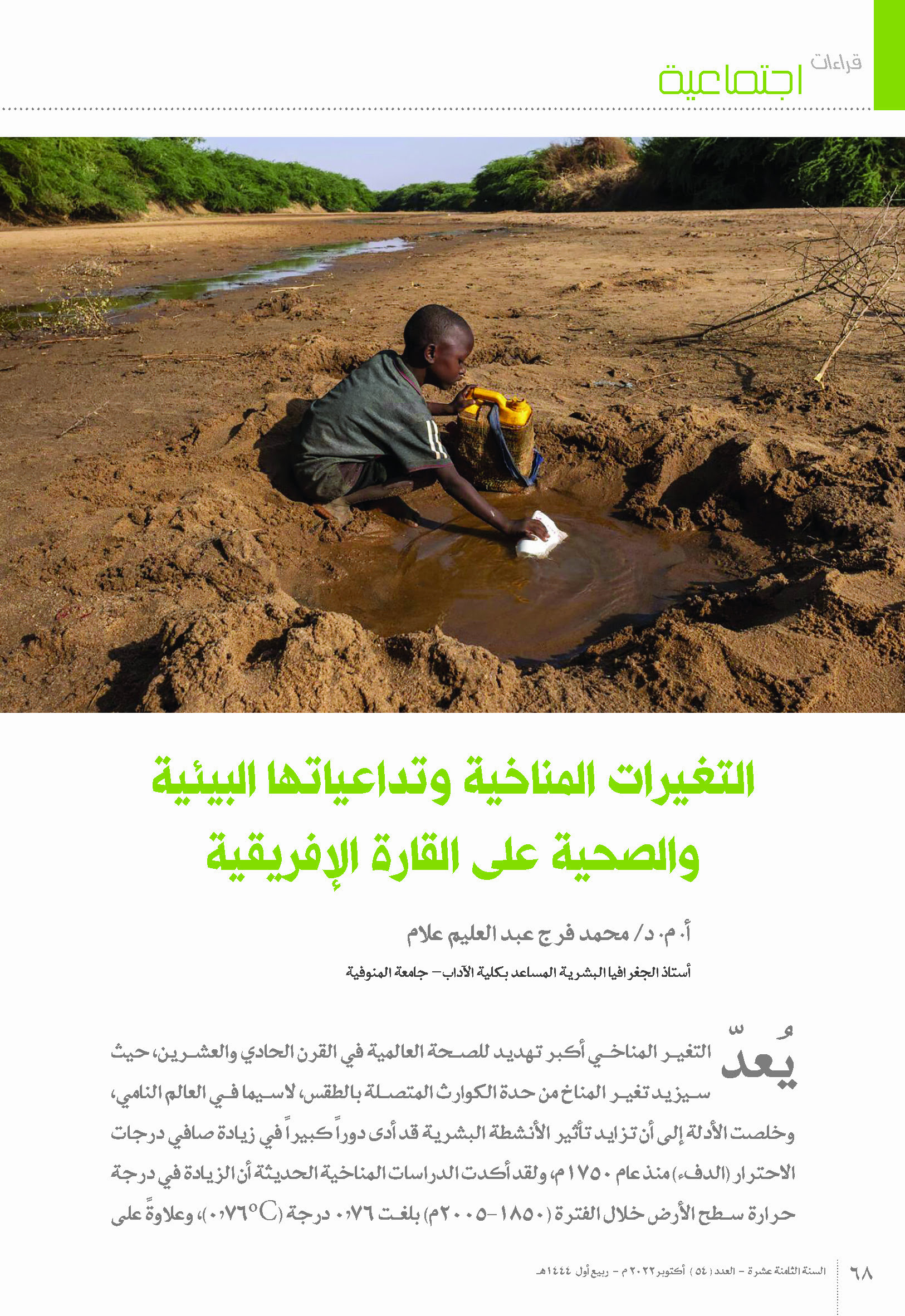Abstract: Climate change is the biggest threat to global health in the twenty-first century, as climate change will increase the severity of weather-related disasters, especially in the developing world, and the evidence concludes that the increasing impact of human activities has played a major role in increasing net warming (warmth) since 1750 AD. Recent climatic studies have confirmed that the increase in surface temperature during the period (1850-2005 AD) amounted to 0.76 degrees. Moreover, the linear trend of warming in the last 50 years was recorded by 0.13 degrees per decade. It has the lowest greenhouse gas emissions; However, it will witness the most severe consequences of climate change. The study came in four main axes. The first axis dealt with climatic changes in the continent: features and evidence. During the second half of the last century, the average annual temperature in Africa increased by about half a degree Celsius in some geographical areas of the continent. In the countries of the Nile Basin, it increased by (from 0.2 to 0.3 degrees Celsius in 10 years), and in other countries such as Rwanda it increased by (from 0.7 to 0.9 degrees Celsius in 50 years), and recent climatic fluctuations in Africa indicated a noticeable decrease in the amount of precipitation; This leads to a noticeable decrease in the average discharge of some surface water sources by between 40% and 60% since the early seventies of the last century. This has resulted in a significant decrease in the surface area of most of the natural wetlands in the region, as manifested in Lake Chad. As for the second axis, it dealt with the environmental repercussions of climate change, as the possible repercussions of climate change on the ecosystem of the brown continent were numerous, both on ecosystems and biodiversity, and the water security of the continent, and the areas and areas affected by desertification, agricultural production and food security, and the third axis completed the negative repercussions of Al-Mansour Al-Health Where he discussed population displacement in some African cities at risk, as in Alexandria (Egypt), Lagos (Nigeria), Banjul (Gambia), Mombasa (Kenya), Abidjan (Ivory Coast), and Bamenda (Cameroon). This is in addition to dealing with the return of diseases and the emergence of other diseases, as climate change or environmental change has caused an imbalance between diseases and humans; Therefore, vector-borne diseases have become the most prominent problems in tropical countries, and the study concluded in its fourth axis by addressing protection and adaptation measures, in terms of maintaining health infrastructure, developing early warning systems and programs to combat infectious diseases.
الملخص: يعد التغير المناخي أكبر تهديد للصحة العالمية في القرن الحادي والعشرين، حيث سيزيد تغير المناخ من حدة الكوارث المتصلة بالطقس، لاسيما في العالم النامي، وخلصت الأدلة على أن تزايد تأثير الأنشطة البشرية قد لعب دوراً كبيراً في زيادة صافي درجات الاحترار (الدفء) منذ عام 1750م، ولقد أكدت الدراسات المناخية الحديثة بأن الزيادة في درجة حرارة سطح الأرض خلال الفترة (1850-2005م) بلغت 0.76 درجة، وعلاوة على ذلك سجل الاتجاه الخطي لدرجات الاحترار في آخر 50 سنة بمقدار (0.13 درجة) في العقد الواحد، وعلى الرغم من أن أفريقيا تعد أقل القارات من حيث انبعاثات الصوبة الزجاجية؛ إلا أنها ستشهد أفدح عواقب لتغير المناخ. ولقد جاءت الدراسة في أربعة محاور رئيسة، تناول المحور الأول: التغيرات المناخية بالقارة: الملامح والأدلة، حيث زاد متوسط درجة الحرارة السنوية في أفريقيا خلال النصف الثاني من القرن الماضي، بنحو نصف درجة مئوية في بعض المناطق الجغرافية بالقارة، ففي بلدان حوض النيل زادت بمقدار (من 0.2 إلى 0.3 درجة مئوية في 10 سنوات)، وفي بلدان أخرى مثل رواندا زادت بمقدار (من 0.7 إلى 0.9 درجة مئوية خلال 50 سنة)، كما أشارت التقلبات المناخية الأخيرة في أفريقيا إلى انخفاض ملحوظ في كمية الأمطار؛ بما يفضي إلى انخفاض ملحوظ في متوسط تصريف بعض مصادر المياه السطحية بما يتراوح بين 40 % و60% منذ أوائل السبعينات من القرن الماضي. وقد أسفر ذلك عن انخفاض ملموس في مساحة سطح أغلب الأراضي الرطبة الطبيعية في الإقليم، كما تجلي في بحيرة تشاد. أما المحور الثاني فتناول التداعيات البيئية للتغير المناخي، حيث تعددت التداعيات المحتملة لتغير المناخي على النظام البيئي للقارة السمراء، سواء على النظم الإيكولوجية والتنوع الأحيائي، والأمن المائي للقارة، والمناطق والمساحات المتأثر بالتصحر، والإنتاج الزراعي والأمن الغذائي، واستكمل المحور الثالث التداعيات السلبية من المنصور الصحي، حيث ناقش التهجير السكاني في بعض المدن الأفريقية المعرضة لخطر، كما في مدينة الإسكندرية (مصر)، ومدينة لاغوس (نيجيريا)، ومدينة بانجول (غامبيا)، ومدينة مومباسا (كينيا)، ومدينة أبيدجان (ساحل العاج)، ومدينة باميندا (الكاميرون)، هذا فضلاً عن تناول عودة أمراض وبزوغ أخرى، حيث أحدث تغير المناخ أو التغير البيئي اختلال التوازن بين الأمراض والإنسان؛ لذا أصبحت الأمراض المنقولة بالنواقل أبرز المشاكل بالبلدان الاستوائية، واختتمت الدراسة في محورها الرابع بتناول إجراءات الحماية والتكيف، من حيث صيانة البنية التحتية الصحية، وتطوير نظم الإنذار المبكر وبرامج مكافحة الأمراض المعدية.







































